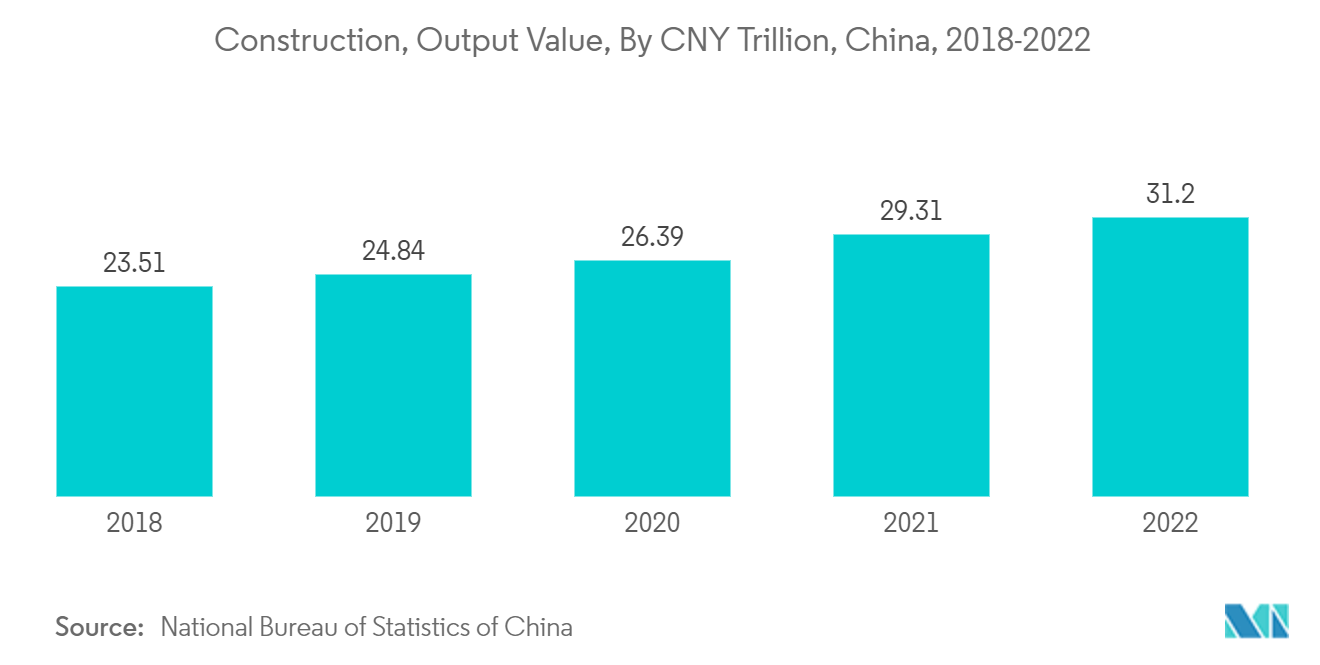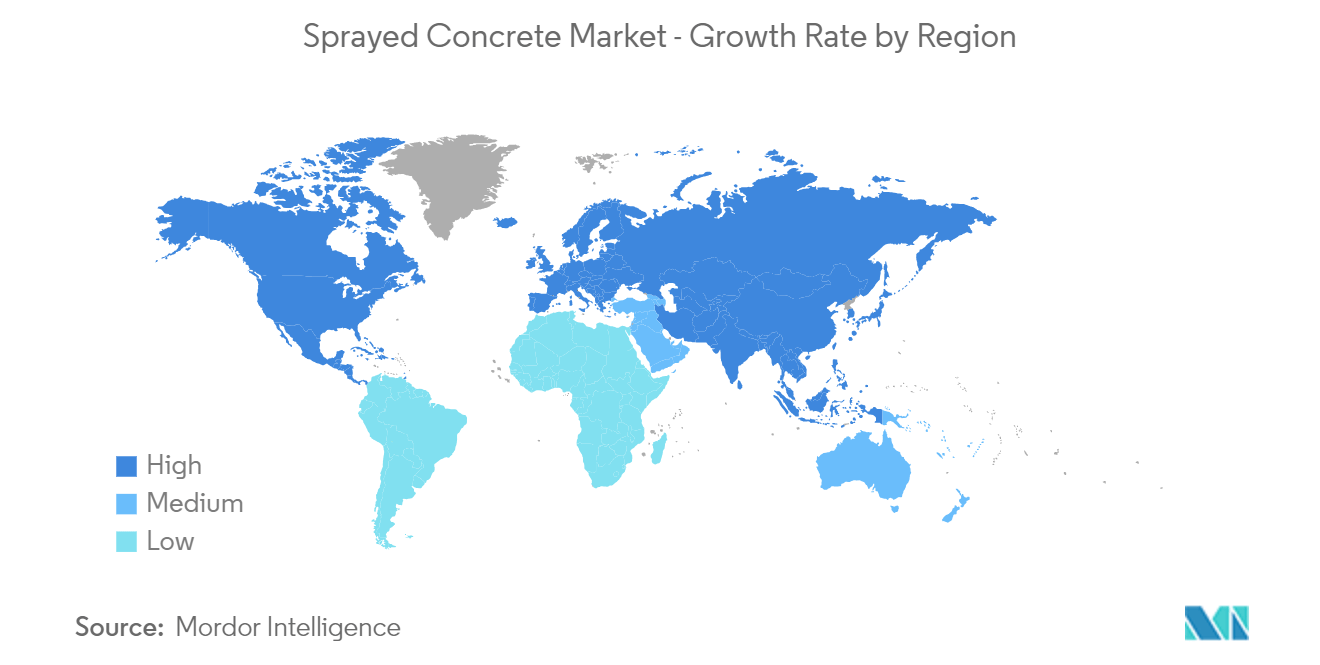Market Trends of Sprayed Concrete (Shotcrete) Industry
Increasing Demand From Construction Sector
- Sprayed concrete finds applications in a range of infrastructure projects. For instance, it's used to create strong seawalls and barriers along coastlines to protect against erosion and storm surges. Additionally, in the realm of transportation, it plays a role in constructing and fixing airport features like runways and terminals. Moreover, it's employed in the construction and improvement of underground facilities such as metro systems and parking garages.
- US cement companies produced 95Mt of cement in 2022, up by 2.2% year-on-year from 93Mt in 2021, according to the United States Geological Survey (USGS).
- Additionally, the US Census Bureau highlighted a surge in U.S. construction output, reaching USD 1,792 billion, up by over USD 166 billion from the previous year. This uptick in cement production signals promising prospects for the sprayed concrete market, suggesting potential growth and expanded opportunities.
- As per the National Bureau of Statistics of China, in 2022, the production volume of cement in China amounted to almost 2.13 billion metric tons and 2.33 billion metric tons in 2021 a 9% decline. The government announced to reduce the output, in order to address the production overcapacity in the cement sector. Despite this shift might still stimulate growth in the sprayed concrete market due to ongoing construction demands and an emphasis on construction efficiency and sustainability.
- In fiscal year 2022, Japan's construction industry, as per the Ministry of Finance, saw sales of about JPY 149.8 trillion (USD 1.15 trillion), a 9.6% rise from the previous year. With growing construction activities, there's heightened demand for versatile and efficient materials like sprayed concrete, especially for infrastructure, tunnels, and bridges.
- According to the Ministry of Finance (India), the real gross value added (GVA) in the construction industry in FY2023 surged by over 9%. In contrast, there were contractions of -8.6% in FY2021 and a growth of 10.7% in FY2022. The pandemic impacted the construction sector in 2021. However, signs of recovery are evident and expected to drive the sprayed concrete market during the forecast period.
- Underground applications of shotcrete include supplementing or replacing conventional support materials, such as lagging and steel sets, sealing rock surfaces, channeling water flows, and installing temporary support and permanent linings. Significantly growing expansion programs within the transportation and water/wastewater sectors are expected to provide a boost to the underground construction activities.
- All the aforementioned factors are expected to drive the sprayed concrete (shotcrete) market during the forecast period.

Asia-Pacific Region to Dominate the Market
- In 2022, According to the US Geological Survey, global cement production showed China as the leading producer with 2,100 million metric tons, followed by India at 370 million metric tons, and Vietnam at 120 million metric tons. All three leading producers are from the Asia-Pacific region, highlighting its dominance in the cement industry on a global scale.
- The mining and quarrying sector often requires infrastructure development for operations such as building tunnels, shafts, and underground structures. Sprayed concrete is essential in these applications due to its strength, durability, and adaptability to challenging environments.
- According to the General Statistics Office of Vietnam, in 2022, the mining and quarrying sector contributed approximately VND 268.1 trillion (USD 11.65 trillion) to the GDP, making up 2.82% of the nation's total GDP. This marks a significant rise from VND 206.2 trillion (USD 8.96 trillion), or 2.42% of the GDP, in 2021, indicating a 30% increase. With the expansion of the mining and quarrying sector, there is an increased demand for sprayed concrete in applications such as ground support, tunnel linings, and mine shafts.
- India's mining industry witnessed a growth of approximately 12% in FY2022, as reported by the Department for Promotion of Industry and Internal Trade (India).
- Additionally, as indicated by the Department for Promotion of Industry and Internal Trade (India), the annual growth rate for cement production in India saw positive shifts: 20.8% in FY2022, -10.8% in FY2021, and -0.9% in FY2020, reflecting a rebound from the pandemic's effects. This recovery trajectory is expected to have a positive impact on the Sprayed Concrete Market.
- As per the National Bureau of Statistics of China, the construction industry in China generated an output of over CNY 31 trillion (USD 4.61 trillion) in 2022, representing an increase of 10% of CNY 29.31 trillion (USD 4.36 trillion) compared to the previous year and there is an increase of almost 100% from a decade ago with a steady growth y-o-y. The growing construction sector broadens sprayed concrete's applications, from residential and commercial structures to specialized infrastructure, boosting its market demand and reach.
- According to MLIT (Japan), private sector building construction investment in Japan reached approximately JPY 37.1 trillion (USD 0.26 trillion) in fiscal year 2022, significantly influencing the sprayed concrete market. Additionally, projections suggest that private investment in building construction will maintain this level into fiscal 2023, indicating a sustained demand for sprayed concrete.
- Hence, all such market trends are expected to drive the demand for the sprayed Concrete (shotcrete) market in the Asia-Pacfic region during the forecast period.


